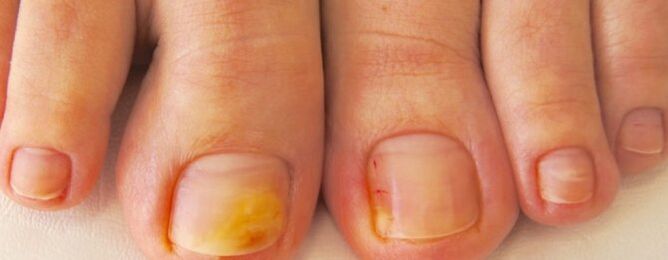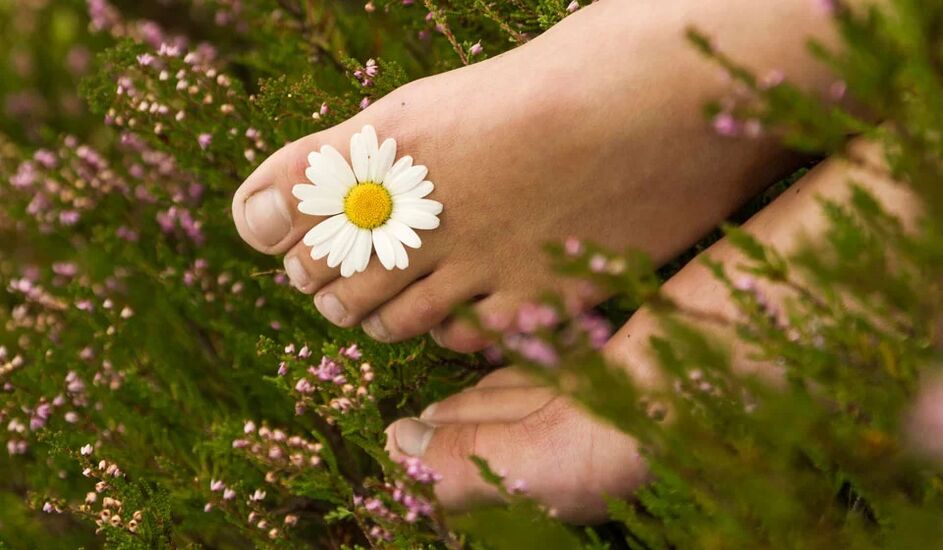In medicine, nail fungus is officially called onychomycosis.This is an illness with a mushroom that affects the nail plates on the fingers or legs.According to the WHO, this is a rather common illness.In about 27% of people, pathology is diagnosed twice more frequently than in the hands.The problem of the nail fungus is very sensitive because the unpleasant type of affected plates feels uncomfortable and hide them from others.
Symptoms and signs of nail fungus
Onichomycosis is very easy to see because their signs of the nails cannot be ignored.First the nail plates become blunt and rough and lose their shiny shine.Instead of pink, the nail gets yellow, whitish or gray.Next, other characteristic symptoms of the mushroom appear:
- an increase in the thickness of the plate;
- Defects in the form of stripes, bends, irregularities and waves;
- Relax and crumb of the plate;
- An unpleasant smell of nails.

As a result, the nail is completely destroyed and even a peeling, which reveals the bed under the nail.The skin next to the panels becomes red and causes severe itching.
Causes
The main reason for the development of fungal infections is to get into the body or the human body.As a rule, it is a microsporator, metridium and epidermofitone.These are the fungi that causes onychomycosis particularly often.
When it enters the body, such fungi are on keratized derivatives of the skin, i.e.H. nails and hair, localized.This is due to the diet of parasites, for which you use fibrillary protein keratin, which is available in nails and hair.
Infection
The risk of infection with a fungus in public places with high humidity is particularly high.These are saunas, pools, gyms, public baths, etc. The most common infection options:
- Direct contact with an infected person.Here the mushroom falls from its habitat in healthy areas, causing an infection.
- Budget path.In this case, an infection occurs when the patient's personal things are used: shoes, personal hygiene articles, etc.
Risk factors
The incidence of onychomycosis increases by 60 years.At this point, the likelihood of developing such an infection is 60%, which is explained by slowing down the metabolism, especially in distal (distant) areas of the body that are only fingers and legs.
Other risk factors for the development of nail fungus are:
- Diabetes mellitus;
- Varicose veins;
- Injuries to nails and adjacent tissues;
- HIV and other states of immune deficiency;
- Long -term recording of antibiotics;
- weakened immunity;
- Vascular and skin diseases, dermatitis, diaper rash;
- Impaired blood supply to the limbs;
- Inadequate hygiene.
Complications
In the event of an uncomplicated course, the disease traditionally causes symptoms for the mushroom and causes a person to complain.But without treatment, onychomycosis can cause complications.Most of the time they appear when adding a bacterial infection.
Sometimes onychomycosis is very acute with the advent of bubbles, ulcers and crying areas on the skin next to the nail.In severe cases, the disease receives a generalized form.This means that the nail fungus applies to internal organs and systems and the patient then needs an emergency hospital hospital.
When should a doctor be consulted
Many who have come across onychomycosis know that the disease is slowly developing and treated with incredible work.It is therefore very important to consult a doctor when the first signs of the disease occur.The treatment of onychomycosis of the nails is involved in a dermatologist.The specialist offers competent support and leads you up to a complete recovery.
Preparation for a doctor
Before taking a dermatologist, it is important not to process the affected areas of nails, i.e.H. You do not use medication, including iodine and green.It is also necessary to exclude the use of creams and ointments from the fungus.It is worth taking off all tests carried out beforehand, including other diseases.The nails affected cannot be cut 3-4 days before the consultation.
Diagnosis of nail fungus
First of all, the patient is aimed at microscopy so that you can identify the presence of the pathogen.In the future it will be necessary to determine its variety to choose the correct treatment of nail fungi on the legs.The most modern and common methods for diagnosing onychomycosis are practiced:
- Bacteriological sowing.For this purpose, a biological sample of affected tissue is placed in an artificial nutrient medium in which the pathogen is grown to determine its type.
- The method of polymerase chain reaction (PCR) to detect the DNA of the pathogen in the trial of affected tissue.
Treatment
In the early stage of the disease, local therapy is usually prescribed, which consists in the use of creams and ointments with antifungal effects.
Antiseptic solutions are also used as external nail fungus products.In addition to effective tools from onychomycosis of the nails, antihistamines and desensitization medication are prescribed that alleviate swelling, inflammation and sensitivity.
If the nail is fully influenced by the fungus and the drug treatment does not provide positive results, the plate is exposed to surgical removal.With a total form of onychomycosis, antifungals are prescribed in the form of tablets that have systemic effect on the body.
Home treatment products
Before you use funds to treat your own homes, you need to consult a doctor.After its solution you can use the following recipes:
- Iodine.Before the leg is used, you have to steam, rinse with the household soap and then remove the affected areas of the nail plates.Treat the nails and skin between your fingers with iodine next, stand in a bathroom with a soda solution for 20-30 minutes and dry them thoroughly.
- Vinegar.Take 1 tablespoon for 3 liters of water.Add apple cider vinegar apple cider vinegar and a small potassium perpetrator.Keep your legs in the bathroom for 20-30 minutes and dry them thoroughly.
- Hydrogen peroxide.Remove the legs thoroughly, remove the affected areas of the nail plates.Put them in with hydrogen peroxide, whereby the cotton plaque is moistened, wrapping with a bandage and leaving for half an hour.
Myths and dangerous delusions in the treatment of nail fungus
One of the most important and dangerous myths is that nail fungus is not regarded as a serious disease.In fact, the progress of onychomycosis can lead to serious consequences for deformation and the complete rejection of nails from the nail bed.
In addition, an infected person is a danger to relatives every day because they also risk getting sick in addition to him.It is therefore important to know how to heal nail fungus in good time.
prevention
In order to prevent the development of onychomycosis, the negative effects on the body of risk factors must be excluded:

- Treat system diseases in time;
- Do not wear someone else's shoes;
- in the pool and in the sauna to go in slate;
- Change the socks daily and follow the personal hygiene rules.
- Do not wear a damp shoes - dry it thoroughly;
- Exclude direct contact with potential mushroom media.


















